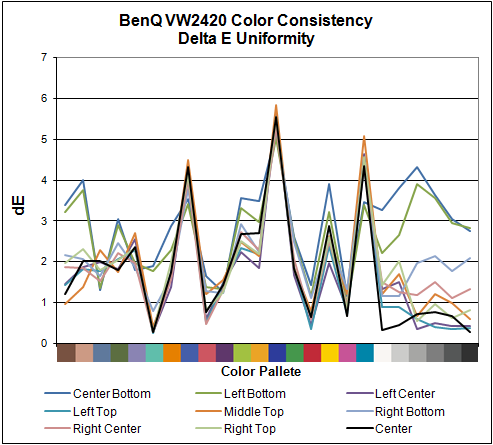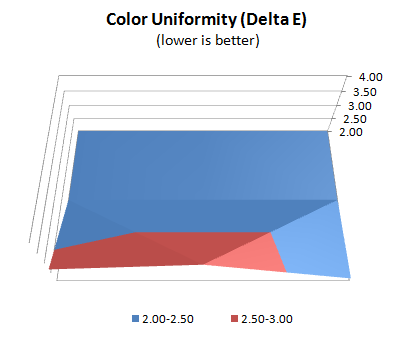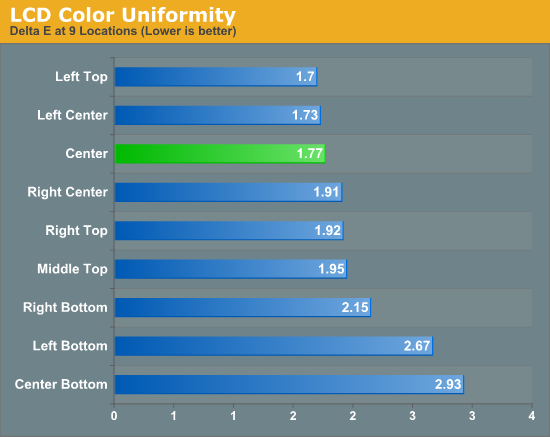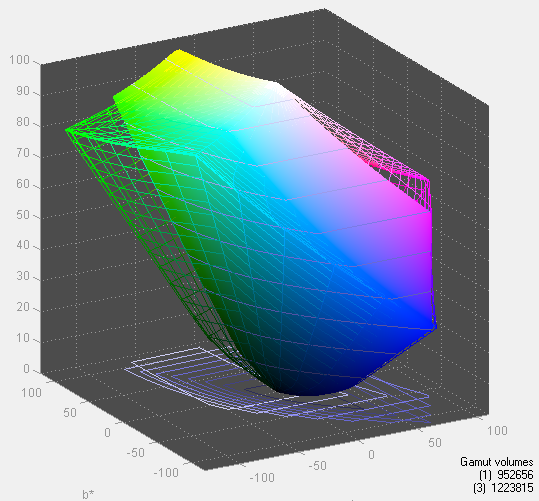Samsung S23A750D 3D LCD Display
by Chris Heinonen on December 17, 2011 2:45 PM ESTSamsung S23A750D Color Uniformity and Color Gamut
Most TN panels that I have seen seem to have uniformity issues around the panel, but this is also probably that TN panels are usually found in less expensive monitors that use less expensive backlighting systems. The Samsung isn’t an inexpensive monitor and has much better uniformity than most panels out there.



Other than the bottom of the display, the Samsung is as uniform a monitor as I have seen so far, and maintains its low dE across most of the screen. Samsung has done a much better job with their TN panel and color uniformity than most vendors out there. That darker lower-right corner doesn’t seem to cause much of a color shift at least, as an uneven backlighting system often can.
Despite only being listed as covering the sRGB gamut, which would mean 71% of the Adobe RGB gamut, the Samsung measured out to cover almost 78% of the Adobe RGB gamut. Compared to a normal sRGB monitor, most of that extra range seems to be in the additional blue colors that are available. As one of the samples used to calculate the dE value that is blue is typically outside of the sRGB gamut, the extra gamut can bring the Samsung closer to being able to display this color, which helps the overall dE.












80 Comments
View All Comments
sviola - Monday, December 19, 2011 - link
Well, I hope it doesn't take much longer. Also, I hope they'll release them with 16:10 aspect ratio.DanNeely - Monday, December 19, 2011 - link
It'd be nice if they manage to get top flight LED backlight color accuracy above that of top flight CFL models before the 120hz refresh too.MadAd - Sunday, December 25, 2011 - link
This is my problem too.I have a triple desktop including x2 1920x1200 IPS screens. Any new 120hz monitor has to fit in, in the center, 1080 isnt going to work.
Why cant we get
-120hz
-displayport
-1200 lines
in one package? I could even wait for IPS, but the aspect ratio is a dealbreaker.
MadAd - Sunday, December 25, 2011 - link
-24"(forgot that one)
The only one ive seen even close is that horrible shape one for an insane amount of money
dingetje - Saturday, December 17, 2011 - link
screw that 16:9 paneli need vertical space....not horizontal space....i don't need a television, i need a pc screen
mac2j - Sunday, December 18, 2011 - link
I have a S27A950D, which is pretty much the same panel but 27". I actually have been pleased with the interface and have had no problems with it - although perhaps the buttons are more spaced on the 27"?The picture is amazing and I can't imagine buying another monitor that isn't at least 120hz - its not just the smooth motion and drag, etc - it's hard to describe how good and crisp the picture on this monitor really is. I have a really nice 240hz TV in the same room and if I play a Blu-ray and mirror it on the 2 screens it looks noticeably better on the monitor - better colors, better color depth, better blacks, brighter ... just all around an amazing monitor.
It would be nice if we could get a 2560 x 1440 monitor at 120hz ... which i think Displayport could handle rather than having to choose between the 850D which is 2560 x 1440 or the 950 which is 1080p but 120hz.
wtfbbqlol - Sunday, December 18, 2011 - link
I don't think an LCD's response time is dependent on phosphors.PrinceGaz - Sunday, December 18, 2011 - link
Quite correct. And the response-time of phosphors has never been an issue anyway as every CRT display used them and they could have a near instant response time.AnandTech is certainly going downhill these days.
If Anand reads these comments, he should seriously consider the quality of the reviews being posted on his site, as the quality is becoming increasingly variable, from superb articles which delve into new CPU micro-architecture, to pot-boilers like this which consist mainly of recycled previous stuff combined with the author's own input which is of very dubious quality.
Zan Lynx - Monday, December 19, 2011 - link
CRT phosphors were always an issue in multisync monitors.The issue is that the phosphor had to be chosen so that its persistence matched the refresh rate.
If it lasted too long there would be ghosting. If it was too short the image would flash and cause eye strain.
This was a big problem with CRTs designed for a 75Hz refresh. Running them at 60Hz was pretty awful, yet lots of people did that anyway.
ggathagan - Monday, December 19, 2011 - link
All true, but the overarching point is that LCD screens don't involve phosphor, hence the complaint.